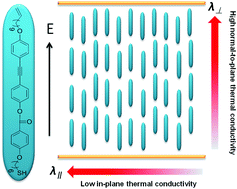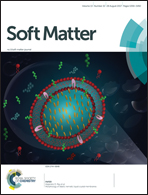A homeotropic main-chain tolane-type liquid crystal elastomer film exhibiting high anisotropic thermal conductivity†
Abstract
The development of pure polymeric films with anisotropic thermal conductivities for electronic device packaging applications has attracted intense scientific attention. In order to enhance the polymeric film's normal-direction thermal conductivity, homeotropic alignment of macromolecular chains is the primary concern. One of the promising preparation strategies is to perform in situ photopolymerization of homeotropic-oriented liquid crystal monomers. In this work, we design and synthesize a novel tolane-core thiol–ene-tailed liquid crystal monomer. Benefitting from the conjugated and extended tolane π-system of the mesogenic core and length extension of the terminal aliphatic tails, the normal-to-plane thermal conductivity value and the thermal conductivity anisotropy value of the corresponding cross-linked main-chain end-on liquid crystal polymer (xMELCP) film reach 3.56 W m−1 K−1 and 15.0, respectively. Compared with the data of a previously reported ester-type thiol–ene xMELCP film, the two primary values of this novel tolane-type thiol–ene xMELCP material are increased dramatically by 46% and 29%, respectively.

- This article is part of the themed collection: Liquid Crystal Elastomers


 Please wait while we load your content...
Please wait while we load your content...